The work of Leilah Babirye, who was born in Uganda and now lives in New York, encompasses painting, drawing and large-scale wooden and ceramic sculptures. In the summer of 2023 she was resident artist at Yorkshire Sculpture Park, crafting a series of sculptures using materials from across the grounds, including a fallen 200-year-old beech tree and found objects such as bicycle chains and nails. Much of Babirye’s work draws on her experiences of homophobia in Uganda and elsewhere: she has described her frequent use of discarded materials as referring to the Luganda word abasiyazi, a derogatory term for gay people that means sugarcane husk. Her exhibition ‘Obumu (Unity)’ takes place at Yorkshire Sculpture Park from 23 March–8 September.
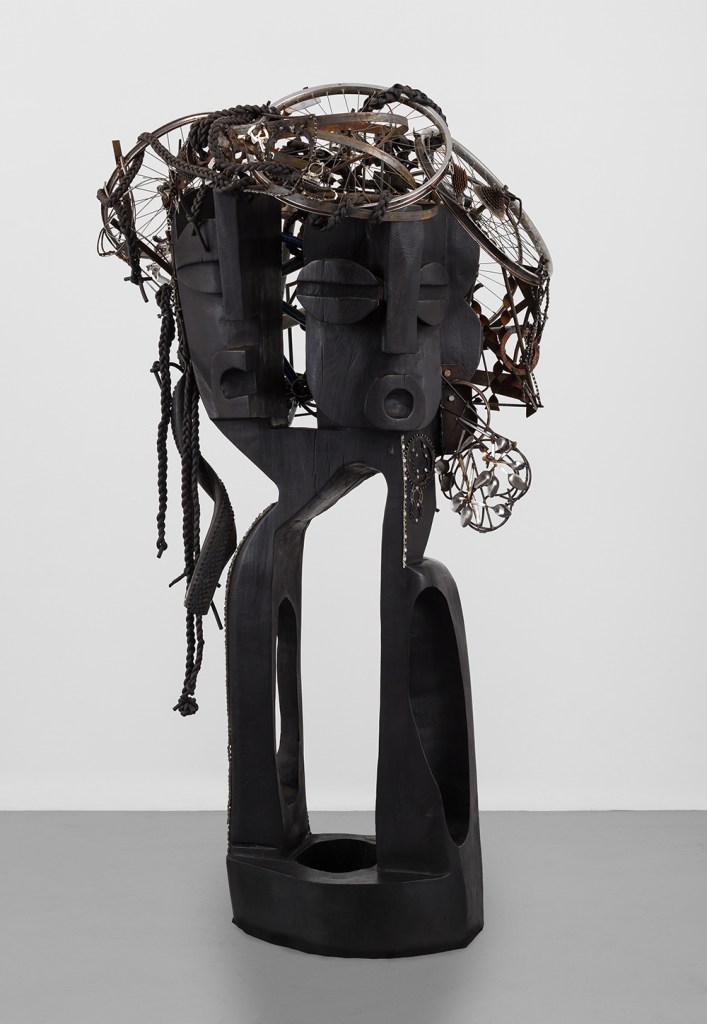
Gunsinze aliwa Bitono (2023), Leilah Babirye. Photo: Mark Blower. Courtesy the artist/Stephen Friedman Gallery, London and New York/Gordon Robichaux, New York; © the artist
Where is your studio?
I have two studios: one in Queens, for ceramics, and another in Brooklyn, where I do my sculptures. I also have another space in Brooklyn where I put the finishing touches to works, so I take my ceramics from Queens and finish them off in Brooklyn.
How would you describe the atmosphere where you work?
My sculpture studio is very much a working zone. I have a studio manager, and when she comes in I have to clean up so she doesn’t get dust and paint on her clothes when she sits down. I’ve been to studios that feel like homes, but mine is different. We don’t come here to sit around for six hours; we’re here to work, and then we leave. It’s not a place of relaxation, and I wouldn’t accept that in my studio.
My ceramics studio is a little more relaxing. It’s a shared space. When working with ceramics, everybody’s in a meditative frame of mind: it’s quiet and almost romantic in there. The atmosphere is totally different.
There are often people coming in and out of the studio. It depends what project I’m working on, but at the moment I have two studio assistants who just come in to polish things, and then a studio manager who deals with my emails and so on. I’ve got a lot on at the moment, including the Venice Biennale and the show at Yorkshire Sculpture Park, so I need helpers.
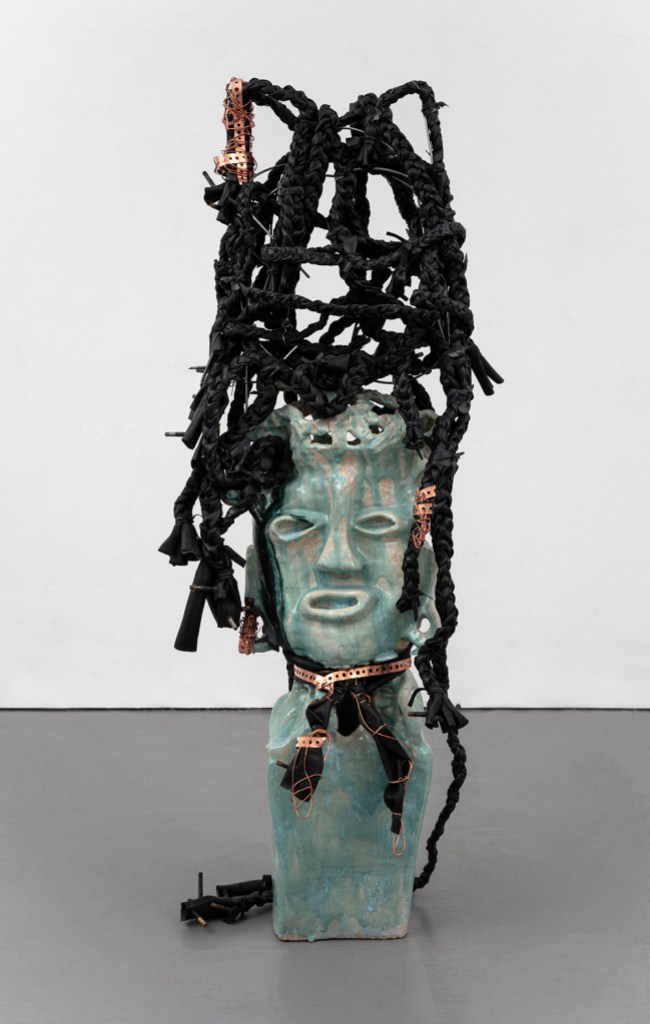
Nakalanzi from the Kuchu Nsenene (Grasshopper) Clan (2023), Leilah Babirye. Photo: Jean Vong. Courtest the artist/Stephen Friedman Gallery, London and New York/Gordon Robichaux, New York; © the artist
How does the studio at Yorkshire Sculpture Park compare to your New York studios?
I wish Yorkshire was my other studio! It’s a very beautiful space. The studio there is so professional, so high end. It’s been there for a long time, and lots of famous sculptors have worked in that space. It’s very well equipped, with tools that I can’t imagine having in my own studio. Even the space itself is overwhelming because it’s so big and so well organised. I can’t compare it to my New York studios at all; they have totally different atmospheres.
Is there anything that frustrates you about your space?
No. Why would you come to a studio if it was a frustrating place? If I was frustrated by my studio then I would rather not go there. It wouldn’t make sense to me to work in a space I didn’t enjoy being in.
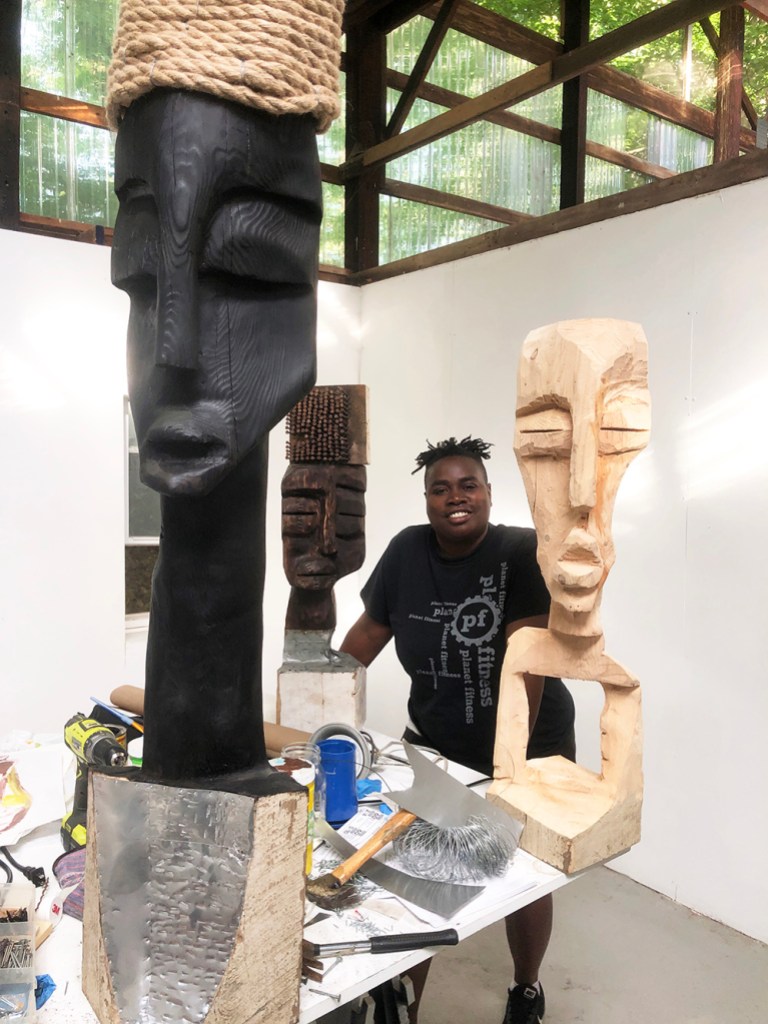
Leilah Babirye during her Art Omi residency, New York, 2019. Photo: Jacob Robichaux; courtesy Gordon Robichaux and Stephen Friedman Gallery
Do you have a specific studio routine?
I make sure I’m at my sculpture studio by 11am. I work on my sculptures there, and sometimes I paint. Then at some point before 3pm I jump in an Uber and head over to my ceramics studio in Queens. I usually stay there for an hour; any longer and I stop being able to think. I head home at around 4 or 5pm. I usually go to the gym, either before work or in the evening. Then I watch a movie and go to bed at 11 on the dot. That’s my schedule every single day. I don’t do much else; I don’t really go out.
Do you listen to anything while you work?
It depends on the mood, but not very often at all. If I do listen to music, it will usually be Ugandan music – slow jams and other Ugandan songs. But generally I like it quiet. I want to listen to the tools. I have lots of tools, and I listen to them working. If I were to play music, it would get stuck in my head and that would distract me from my work.
I’m very attuned to sound in my studio: when one of my assistants is using a tool, I can hear if they’re doing it wrong. I’ll tell them, ‘Oh, the way you’re hammering that nail, it’s going to bend’, and within a couple of minutes the nail bends! I like it that way; I enjoy listening. And I often talk to my works, so I don’t want music to interrupt me when I’m interacting with my art.
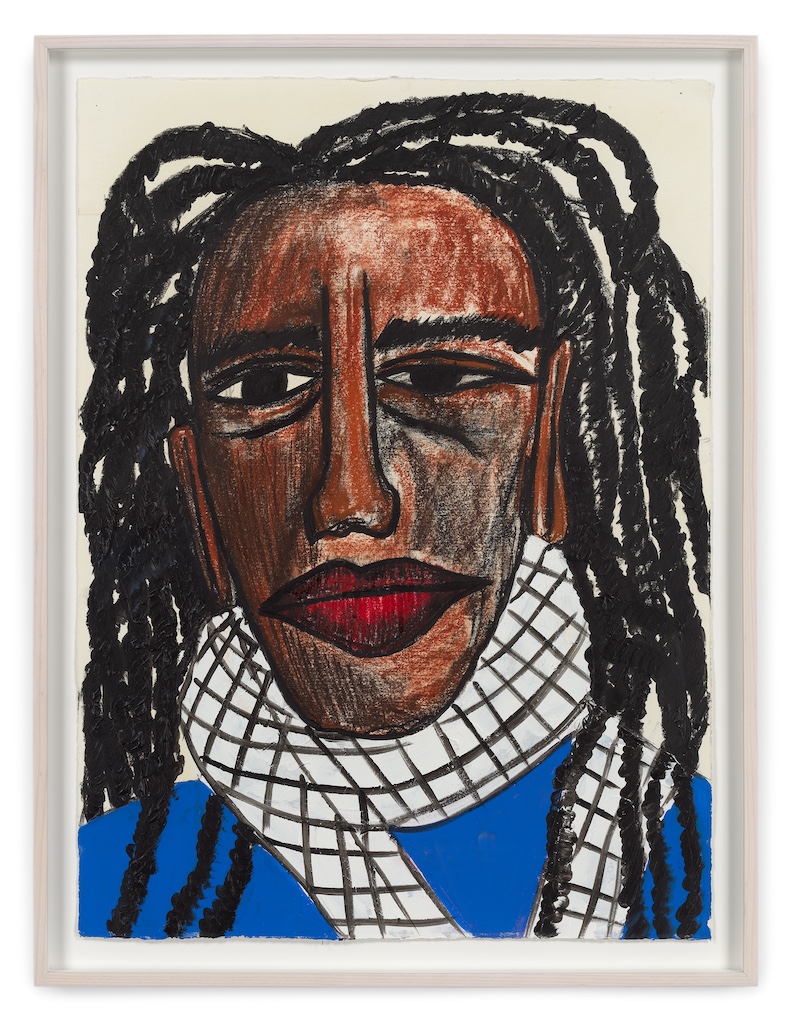
Kuchu Ndagamuntu (Queer Identity Card) (2023), Leilah Babirye. Photo: Dan Bradica; courtesy the artist/Stephen Friedman Gallery, London and New York, Gordon Robichaux; © the artist
What’s the most unusual object in your studio?
I don’t have many unusual objects, but I do keep two whisky glasses here. I like Japanese whisky. Once in a while I’ll bring in a bottle – I did yesterday actually – and we’ll have a glass or two.
What’s your most well-thumbed book?
I read a lot of Luganda books by professors back home, because much of my work is based on historical case studies from Buganda and I don’t like to misspell things, so I read literature by professors back home. Most people of my generation or younger, and even some people my parents’ age, don’t know much about this history. I want to make sure that the information I’m giving people is correct, so I read about it very carefully. I’m especially interested in Uganda’s clans – their history and origins.
I’m also trying to do more painting and drawing at the moment, so I look at art books. Recently I’ve been looking at books of paintings by Alice Neel, for instance, and Tabboo!, who is an artist here in New York.
Who is your most frequent visitor?
Probably Audrey, my studio manager, or my gallery assistants. I also have a gallerist friend here in New York called Jacob, and he often drops by my studio just to see what I’m working on and say hello. He really likes my work and often he comes by not on business, but just to appreciate my art and see what I’m working on.
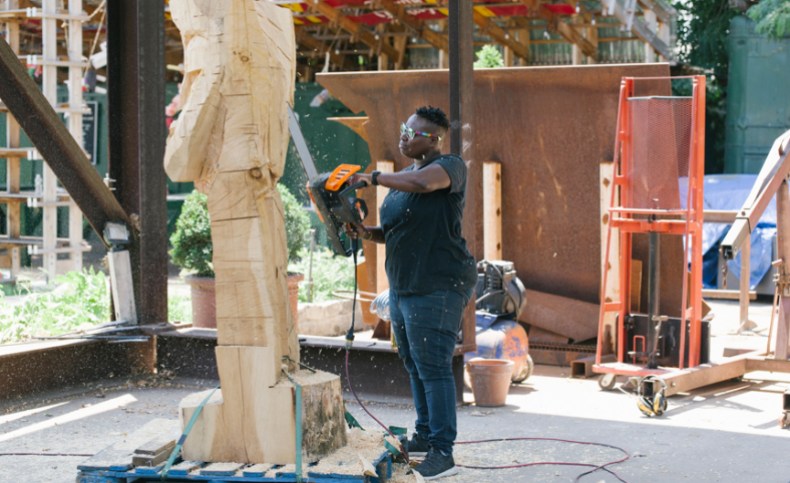
Leilah Babirye working on one of her wooden sculptures. Photo: Mark Hartman
‘Leilah Babirye: Obumu (Unity)’ is at Yorkshire Sculpture Park from 23 March–8 September
Unlimited access from just $16 every 3 months
Subscribe to get unlimited and exclusive access to the top art stories, interviews and exhibition reviews.

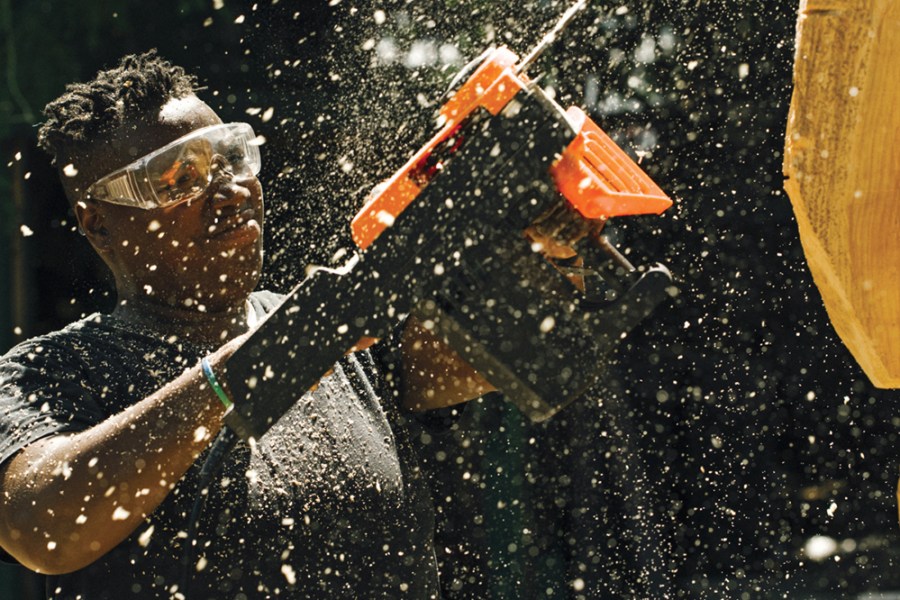
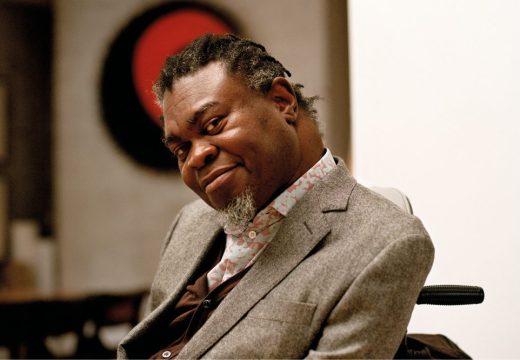
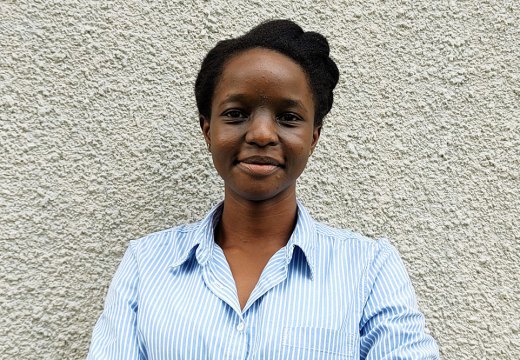
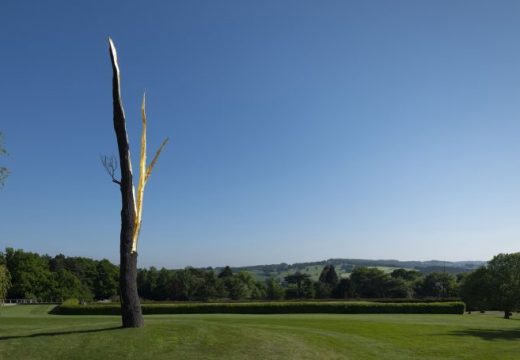









![Masterpiece [Re]discovery 2022. Photo: Ben Fisher Photography, courtesy of Masterpiece London](http://www.apollo-magazine.com/wp-content/uploads/2022/07/MPL2022_4263.jpg)
Has the Fitzwilliam lost the hang of things?